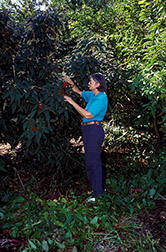Science Update
|
|
Landscapers, Birds To Get Cold-Hardy Viburnum
To cooperating wholesale nurseries, ARS scientists have distributed Cree, a new leatherleaf viburnum, Viburnum rhytidophyllum. Plants are expected on the market in 1996 or 1997. The scientists selected Cree for its compact growth and superior dark-green foliage. It is cold hardy and evergreen in USDA hardiness zones 6 to 8—that is, where the average annual minimum temperature ranges from -10° F to 20° F. In 13 years, densely branched Cree shrubs grew 8 feet tall and 8 feet wide. Cree's small, creamy-white flowers open in 3- to 4-inch-diameter clusters. Loads of bright-red berries, attractive to birds, begin to ripen in late August (in zone 7) and turn black as they mature.
USDA-ARS U.S. National Arboretum, 3501 New York Ave., N. E., Washington, DC; phone (202) 245-4539.
Toxin Arrests Essential Fat
Scientists have begun to uncover the disease-causing mechanism of a toxin called fumonisin. Fusarium fungi that can infect corn make this toxin. In rare instances, farm animals become sick after consuming corn containing high levels of fumonisin. Recently, ARS and Emory University scientists found a direct link between fumonisins and sphingolipids, a class of essential fats in plants and animals. This discovery may lead to reducing the fumonisin threat. In the studies, high fumonisin levels stopped cells from making the sphingolipids. Instead, sphinganine, one of this fat's building blocks, accumulated to high levels. Also, cell division accelerated or slowed abnormally—often an early disease sign. Little is known about the dietary role or biological function of the mysterious fats (the "sphin" is from "sphinx"). But the new findings suggest they help protect plants and animals from disease.
Ronald Riley and Kenneth Voss, USDA-ARS Richard B. Russell Agricultural Research Center, 950 College Station Road, Athens, Georgia 30605; phone (706) 546-3288.
Net Gains New Resource on Pesticides
Water pollution by agrichemicals can be better evaluated with a new Internet resource. The ARS Pesticide Database is now available worldwide to pesticide companies, water resource managers, farmers, environmental groups, and others. It covers hundreds of pesticides, including more than 95 percent of the most popular ones for controlling weed, insect, and fungal pests of crops. For each pesticide, the database describes up to 16 chemical, physical, and biological features that influence its breakdown rate and likelihood of entering surface or groundwater. The data are for use in crop and soil computer models. These models account for soil, temperature, and other local factors that affect pesticides.
Basil Acock, USDA-ARS Remote Sensing and Modeling Lab, Beltsville, Maryland; phone (301) 504-5827.
Modeling the Effect of Climate Change on Western Hydropower
Mountain snowmelt water, once it reaches rivers like the Colorado, drives hydropower plants that keep the West's batteries charged. But power companies need to plan, to ensure that hydroelectric capacity meets future demands. To help, ARS scientists have begun a new project. It's aimed at projecting whether global warming might change volume and timing of snowmelt available for electricity—and drinking, irrigation, and other uses. The scientists will carry out the project under a cooperative research and development agreement with the Electric Power Research Institute (EPRI) and U.S. Geological Survey (USGS). First, ARS scientists will improve an existing ARS model used to forecast snowmelt. Then EPRI can begin generating climate change scenarios for power companies. Eventually, snowmelt and other models—from participating ARS labs in Tucson, Arizona; Boise, Idaho; and Beltsville, Maryland—will be part of a USGS model.
USDA-ARS Hydrology and Remote Sensing Laboratory, Beltsville, Maryland; phone (301) 504-7490.
"Science Update" was published in the November 1995 issue of Agricultural Research magazine.







